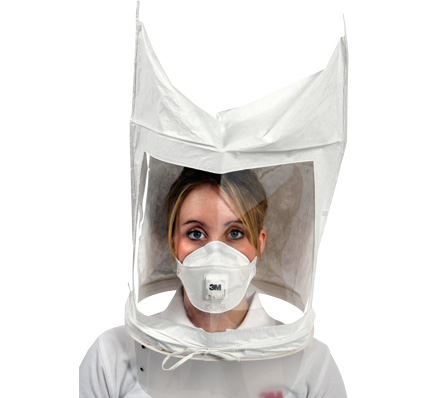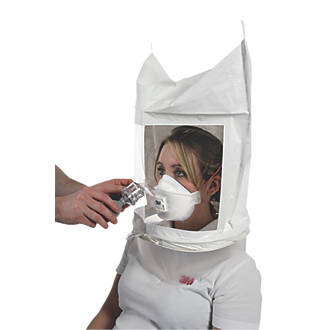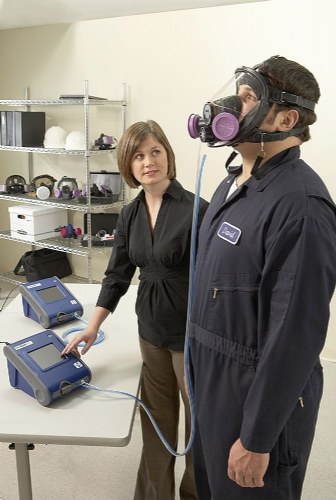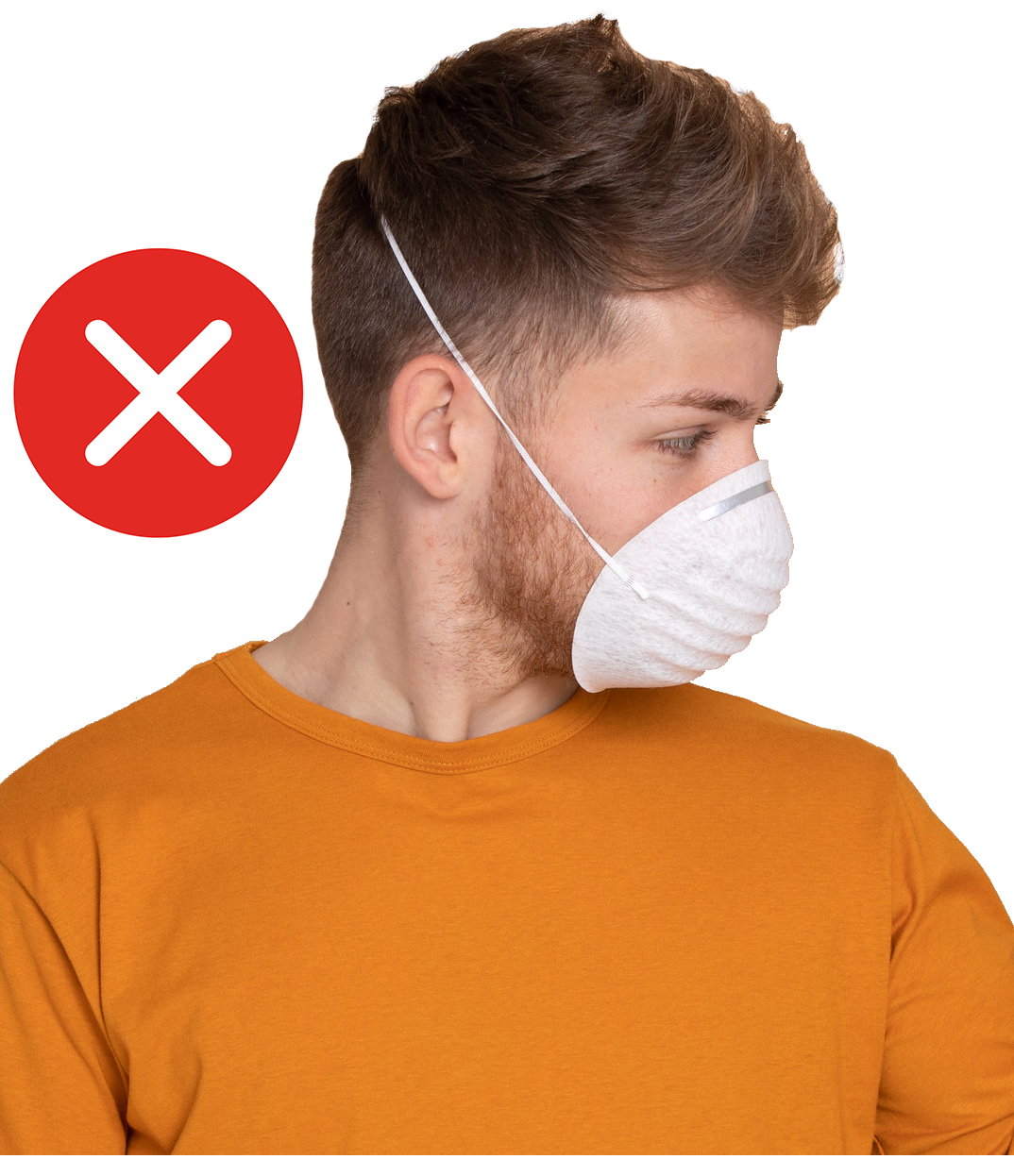Many common types of respirators are tight-fitting (negative pressure) where performance relies on a good seal between the respirator and the worker’s face to minimise the risk of exposure to airborne contaminants.
People's faces vary significantly in size and shape so it is important that a tight-fitting respirator is a suitable fit for each worker.
Fit testing
Fit testing detects for air leaks around the seal between the respirators facepiece and face of the worker. If there isn’t a good seal, contaminated air will leak into the respirator and the worker may not get the level of protection that is needed to protect their health.
Workers must pass a respirator fit test before they first start wearing a tight-fitting respirator. Fit testing is required for all types of tight-fitting respirators, such as:
- half-face disposable
- half-face reusable
- full-face reusable
- tight-fitting Powered Air Purifying Respirators (PAPR).
If a worker does not pass a fit test, the worker may obtain a better fit by trying a respirator of a different size or model or made by another manufacturer. Alternatively, a respirator that doesn’t rely on a tight-fitting face seal, such as a hood type may be selected if suitable.
All fit testing must be carried out by a competent person such as occupational hygienist, manufacturer, supplier or consultant or a trained in-house person:
- before wearing a tight-fitting respirator for the first time
- each time a new make or model of respirator is issued
- whenever there is a change in the workers facial characteristics or features which may affect the facial seal (e.g. large weight loss or gain).
Fit testing is a great training opportunity, as it highlights to the worker the consequences of poor fit and improper use on the effectiveness of the respirator.
Fit testing methods
Fit testing helps to identify unsuitable styles of tight-fitting respirators that do not provide adequate protection and should not be used by the individual worker, and conversely suitable styles of respirators that should be used by the individual worker.
There are two methods of fit testing that meet AS/NZS1715:2009 Selection, use and maintenance of respiratory protective equipment
Fit testing for your respirator: https://www.youtube.com/watch?v=LDoi06V-AZM
Qualitative
Qualitative testing is suitable for disposable filtering face pieces and can be undertaken by a competent person at the workplace. Qualitative methods are based on the worker detecting leakage through the face seal region using a bitter/sweet tasting aerosol or odour compounds e.g. Saccharin. This is a pass or fail test only.
Qualitative fit testing results are more subjective than quantitative testing because some workers have difficulty with their ability to taste or smell. This can result in a potential for a false pass to the qualitative fit test and worker health not being adequately protected.


Quantitative
Quantitative fit testing is suitable for half-face respirators, full-face respirators and PAPR and gives a numerical measure of the fit. Specialised equipment is required to conduct the measurement, which typically involves a laboratory test chamber or a portable fit testing device. This is a more stringent pass/fail test that demonstrates the level of performance of the respirator with a measurable result for a particular mask on a particular individual.
Full-face respirators and PAPR must be fit tested using the quantitative method. The testing of power assisted facepieces is carried out with the respirator temporarily converted into a negative pressure respirator by adapting the facepiece to use a P3 filter instead of the air supply.

RESP-FIT Partnership
SafeWork SA has partnered with RESP-FIT to help businesses ensure workers are receiving maximum protection in the workplace.
RESP-FIT, Australia’s respirator fit testing training and accreditation program is run by the Australian Institute of Occupational Hygienists (AIOH).
For more information on fit testing:
Fit-checking
Each time a tight-fitting respirator is put on, the worker should carry out a fit check.
A fit-check is a quick check to ensure the respirator, which has been fit tested, has been properly positioned on the face and there is a good seal between the respirator and face.
Fit-checks do not replace the need for a fit test.
If the workers safety glasses fog up when wearing a half-face respirator, this indicates there’s a leak at the top of the respirator.
For further information on fit checking:
- follow the manufacturer's instructions
- see the SA Health training tool for the Use of Personal Protective Equipment (PPE) and Particulate Filter Respirator (PFR) Fit Testing
Facial hair and respiratory protection
Workers must take all necessary steps to ensure the proper fit and use of RPE. When wearing tight-fitting respirators, workers must ensure an effective face seal.
Facial hair, including beards, moustaches, sideburns and stubble (even one day’s growth) that lies along the sealing surface of a tight-fitting respirator will stop the respirator from sealing properly. Fit testing must be carried out on males when they are clean-shaven or have no hair between their face and the fitting surfaces of the respirator facepiece.

Men who need to use a tight-fitting respirator need to remain clean-shaven or only have facial hair that doesn’t interfere with the fitting surfaces and the valve of the respirator.
For workers who want to keep facial hair that may interfere with the operation or proper fit of tight-fitting respirators, a powered air purifying respirator with a loose hood will provide the protection needed.
See Breathe Freely Australia information on Facial Hair and Face Masks.
Short-term or infrequent exposure
For short-term or infrequent exposure, such as during minor maintenance work or drilling a couple of holes in a masonry wall, it may not be reasonably practicable to undertake a fit test prior to use. In these circumstances, the worker must:
- follow the manufacturer’s instructions on how to put on and fit check the respirator
- make sure they are clean-shaven where the respirator touches the face
- make sure no clothing or jewellery gets between the respirator and the face
Studies have shown that people still receive some reduction in exposure if they follow this procedure. However, the level of protection provided by a respirator may be lower without fit testing.
If a tight-fitting seal cannot be achieved with one brand of respirator, then it might be achieved with a different shaped respirator. If a seal cannot be achieved, then the task should not be performed.
Recordkeeping
A person conducting a business or undertaking (employer) should keep a written record of fit tests carried out for each worker, including the:
- type of test performed
- make, model, style and size of respirator tested
- date and result of the test.
Consideration should be given to issuing workers with a fit test record card after their fit test.
Fit testing should be repeated on a regular basis based upon risk assessment (e.g. every one or two years).


